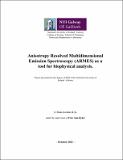| dc.description.abstract | The development of analytical tools for the biophysical analysis of biological
samples is an area of tremendous application and potential. In this work the use and
efficacy of an analytical methodology, known as anisotropy resolved multidimensional
emission spectroscopy (ARMES) [1, 2], as a tool for biophysical analysis
is explored.
ARMES comprises of a 4-D measurement method used in combination with
multi-way data analysis. The ARMES methodology is being developed with the aim
of addressing some of the challenges surrounding the analysis of biological
therapeutics. At present, many available methods used in biological therapeutic
manufacture are either destructive, time-consuming, or alter the sample [3]. Protein
analysis by intrinsic fluorescence is attractive as it is fast, sensitive, inexpensive and
non-invasive, with good robustness, high sample throughput, ease of use and low cost
required for use as a process analytical technology (PAT) tools [4]. Proteins are
generally multi-fluorophore systems, with overlapping emission from the aromatic
amino acids (Trp, Tyr and Phe) which makes multidimensional fluorescence
spectroscopy (MDF) measurement techniques like excitation-emission matrix (EEM)
and total synchronous fluorescence scan (TSFS) potentially beneficial [5-7]. These
MDF methods can be further developed by coupling with factor based chemometric
methods to resolve the individual fluorophore contributions of the intrinsic emission.
In ARMES, an additional dimension of anisotropy (r) is collected, which is related to
rotational speeds, hydrodynamic volumes, and thus molecular size, and adds further
information to the MDF measurement. This ARMES methodology forms the
foundation for this research [2, 8].
In the first project presented in this thesis work, the application of ARMES in
the analysis of Förster resonance energy transfer (FRET) is investigated (Chapter 3
& 4) [9]. FRET is a widely used technique to study the structure and dynamics of
biomolecular systems, and also causes the non-linear fluorescence response observed
in multi-fluorophore proteins, so accurate FRET analysis is critical. Here, a model
system of human serum albumin (HSA) as a FRET donor and 1,8-anilinonaphathalene
sulfonate as a FRET acceptor was used. The results of this work found ARMES
enabled resolution of the fluorescence emission into its constituent fluorophore
emission and facilitated a more accurate analysis of the interactions and photophysical
processes occurring in the HSA-ANS system. This enabled a new way of calculating
biophysical parameters including quenching constants and FRET efficiencies using
the multi-dimensional emission of individual donor fluorophores, and a significant
increase in the FRET efficiency values recovered using the ARMES method was
observed. In addition, ARMES enabled the extraction of the emission arising from
indirect excitation via FRET, which is of significance in understanding the effects of
FRET on MDF spectra.
In the second project of my thesis research, the use of ARMES in investigating
protein-liposome interactions is explored (Chapter 5 & 6). Studying the interaction
between plasma proteins and liposomes is critical for many different scientific
applications, particularly in their use as drug delivery systems (DDS) [10, 11], such as
those used in COVID-19 vaccines [12]. Here, a model system of HSA and DMPC
liposomes was used, and their interactions were monitored in three different aqueous
environments: water (pH ~7.9), NH4HCO3 (ABC) (50 mM, pH ~7.8), and phosphate
buffered saline (PBS) (10 mM, pH ~7.4). Interestingly, a dramatically different
interaction mechanism was observed in each environment with HSA observed to
penetrate the lipid bilayer in water and ABC, but not in the case of PBS. Here, ARMES
enabled the resolution of fluorescence emission into interacting populations of HSA
which had penetrated the lipid bilayer from populations of HSA which were surface
bound or free in aqueous solution and provided an informative approach for
monitoring protein-liposome interactions.
In conclusion, the application of ARMES methodology for biophysical
analysis on two different molecular systems is demonstrated in this thesis work.
ARMES facilitated a more detailed analysis of the photophysical of FRET, providing
a new means of calculating biochemical parameters (FRET efficiencies and quenching
constants) and provided a new way of assessing protein-liposome interactions using
intrinsic protein emission. The studies show ARMES has tremendous potential as a
tool of biophysical analysis of interacting molecular systems. | en_IE |


